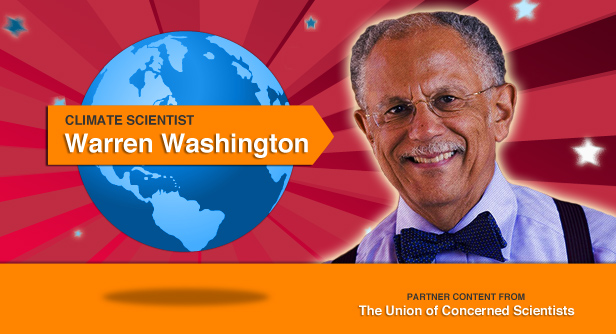Warren Washington literally wrote the book on climate modeling. Introduction to Three-Dimensional Climate Modeling, which he co-authored with Claire L. Parkinson in 2005, is the classic graduate-level text in the field. A former head of the American Meteorological Society and an adviser to every president — Republican and Democrat alike — since Jimmy Carter, Washington has devoted his life to creating increasingly precise and accurate computer models of Earth’s climate.

“What people need to understand is that these are not untested models scientists have dreamed up,” says Washington, now a senior scientist at the National Center for Atmospheric Research (NCAR). “They are based on actual meteorological data and known physics of the atmosphere and oceans. And we have spent many years refining the models by comparing them with observed data.”
In that climate modeling work, as in almost every facet of his life, Washington was a pioneer. As a boy he was fascinated by science, devouring biographies of Thomas Edison and George Washington Carver the way some kids read adventure stories. Despite his passion and aptitude for science, his high school guidance counselor steered him away from college. Washington went anyway, to Oregon State, eventually earning a Ph.D. in meteorology.
Washington’s perseverance was evident early on. When his high school science teacher couldn’t explain what made an egg yolk yellow, young Washington studied chicken diets until he finally traced the yolk’s color to the sulfur in corn and seeds.
That rare blend of initiative and inquisitiveness would serve him well in a field as complex, uncharted, and exacting as the one Washington eventually chose.
When Washington started out, climate modelers were using bulky mainframe computers to test models for weather prediction. They would enter several days’ worth of weather measurements into the large mainframes, then compare their predictions against the actual weather patterns they had observed a few days later. The room-sized computer Washington worked on, called the ALWAC, had to be painstakingly programmed using paper tape.
Since then, both computing power and the variables built into climate models have increased exponentially, but the basic technique remains the same: first Earth, its oceans, and atmosphere are divided into a grid of boxes. Into each box scientists enter real-world data on temperature, pressure, and other variables. These are fed into complex equations based on the physics of fluid dynamics, the chemistry of reactions, various biological processes, and many other factors. The myriad data points then interact with one another to simulate the movements of the atmosphere and oceans that create climate patterns.
In 1978, working with the U.S. Department of Energy, Washington was one of the first scientists to use computer models to study the effects of carbon dioxide concentrations on global temperatures. By that time the computer models of weather were becoming so accurate that Washington and others realized they could use them to project climatic conditions many years into the future. They could also explore not just changes in weather patterns, but larger-scale changes in climate. What they soon saw, with the buildup of greenhouse gases in the atmosphere, says Washington, “was the threat of a dramatic warming trend.”
His current team at NCAR soon became one of the first to practice parallel computing, in which researchers use multiple computer processors simultaneously as a way to include more information about natural variables, such as the effect of sunspots and volcanic eruptions, and about the human impact on climate via greenhouse-gas emissions from fossil-fuel burning and from the tiny atmospheric particles that scientists call aerosols.
Today’s supercomputers use hundreds of processors to handle the billions of computations involved in running the latest versions of climate models. The modeling field has expanded in other ways too. In the early days, recalls Washington, there were only a handful of groups making climate models, with five or six scientists in each group. Today more than 350 scientists might attend a meeting on some highly specialized aspect of the ever-evolving climate models, such as refining treatment of ocean processes or more accurately accounting for changes in soils, vegetation, and permafrost.
Washington stresses that today’s climate models are reliable. They have been subjected to so many tests and trials over such a long period of time that scientists have a high level of confidence in their ability to project how the climate is likely to change when it is subjected to a range of highly specific scenarios. One such test, says Washington, is the so-called twentieth-century reconstruction. Researchers start the computer model with data from 1850 and run it to the present. Only when the model is accurate enough to reproduce the actual climate features of the twentieth century will scientists use it to estimate possible future climate change.
“The most important thing is not just that we can reproduce twentieth-century changes — which we can,” says Washington. “It is that we can go back and rerun the calculations, changing just one thing at a time. In this way the model becomes useful not only for future projections but also for understanding what factors have the most influence on changes in the climate.”
What comes out most clearly, Washington says, is that the model simply cannot reproduce today’s temperature record when scientists remove the increase in atmospheric carbon dioxide from fossil-fuel burning. “To get the kinds of climatic conditions we have today, you need that increase in carbon dioxide. For anyone doubtful about the effect of human activity on global warming, that finding really is a ‘smoking gun.'”
This is the seventh installment of America’s Climate Scientists: A series from the Union of Concerned Scientists. Click here to read all the climate scientist profiles.
The Union of Concerned Scientists is currently leading a campaign to elevate the voices of climate scientists and educate the public about the overwhelming scientific evidence for human-caused global warming. Learn how you can get involved at www.ucsusa.org/evidence.




